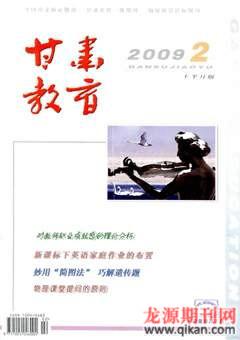英语词汇三步教学法
马兴彪
〔关键词〕 英语词汇;直观法;操练;扩展;使用
〔中图分类号〕 G633.41〔文献标识码〕 C
〔文章编号〕 1004—0463(2009)02(A)—0048—01
一、介绍新词汇
1.翻译法。把单词写在黑板上,然后译成汉语介绍给学生,这样教单词既快又简便,适合初中一、二年级学生。
2.直观法。
1)利用实物介绍新词汇。如:Look,this is a watch.
2)利用图片、简笔画介绍词汇。简笔画要画得快,边画边交流,达到用画表达词义的目的。
3)用模拟、示范动作或面部表情介绍词汇。如:Look——I am opening the door.I am writing some words on the paper.然后利用手势、动作指导学生模仿做。
3.举例。如:教lazy这个词时,就可以说:All of you study hard,but Xiao Ming doesnt study hard.He is very lazy.He gets up late and then does nothing all day.He is not a good student.这样通过一个例子使学生既练习了句子,又清楚、准确地领会了单词lazy的意思及其怎样灵活运用。
4.多元法。同时使用几种方法介绍词汇。如:Look,he is smiling.Now look at me.I am smiling,too.(用面部表情)We smile when we are happy.(作手势让学生重复)学生:smile.老师:Good.What does it mean?(学生说出汉语意思“微笑”)
5.画斜线法。使用斜线来介绍新词。如:I go there/by bus.He goes to school/on foot.在斜线旁给一个句子或一个词,目的是将斜线的词放在有意义的情景中,以区分词的意义上的细微差异。
6.下定义法。如:breakfast——the first meal of a day.A noun is the name of a person,place or thing.
7. 释义法。利用各种关系解释词义。
1)利用事物的特征:Ice is cold.Water turns into ice in winter.Coal is black.Coal burns.When coal burns,we get fire.
2)利用因果关系:Xiao Li has not taken his lunch,so he is hungry.
I have drunk a lot of water,so I am not thirsty now.
3)利用先后关系或自然顺序:
Spring comes before summer.Sunday comes before Monday.We take our breakfast at seven in the morning.We take our lunch at twelve.
二、操练和使用新词汇
1. 操练。
1)教师提出词汇让全班同学思考,在人人思考的基础上,让个别同学说,并让同学们纠正。
2)让学生互相说,鼓励人人开口。
3)做听写练习。让上、中、下三种程度的同学代表到黑板上听写,其余同学在座位上听写,然后让同学们先纠正。
2.使用新词汇。如:学习market时,教师围绕这个词连续提出问题,让学生回答,重复使用这个词,使学生在语言环境中掌握这个词:
Do you often go to the market?Do you live near a market?When does your mother go to the market?What does she buy there?
三、扩展词汇
1.利用关联词群或联想词群扩展词汇。如:教fruit时,指出这是水果的总称,为让学生联想到有关水果的词,教师在黑板上写下关联词群。
2. 将机械记忆和理解记忆密切结合起来。
1)利用拼读规则。学生知道了ar读[a:]的规则后,可帮助记忆arm,art,part,party,dark,argue等词。
2)利用词形变化规则。总结不规则动词的变化:
A—A—A型:cut—cut—cut,put—put—put
A—B—B型:build—built—built,dig—dug—dug
i—a—u型:begin—began—begun,drink—drank—drunk
3)利用构词法知识。
a.利用同根词。如:教过use后,经过构词分析,学生就可以推测出useful,useless,user的词义来。
b.利用分析前缀的方法。如教retell,rewrite时,学生已掌握了tell,write的词义,向他们解释前缀re-的含义,在此基础上学生就能推测出retell,rewrite的意思来。
c.利用分析后缀的方法。如:在学生学过China,Japan的基础上,指出后缀-ese的含义,学生就很容易推测出Chinese,Japanese的意思来。
d.利用分析合成词的方法。如:学生在学过wait与room后,很自然推测出waiting-room,reading-room的含义来。
4)利用归纳、对比法。
a.利用同义词。不要孤立地看某对词是不是同义词,而要把它们放在句子中来看。如:“The weather is nice today”和“The weathe is fine today”.这两个句子中,nice和fine就是同义词,可以相互代替。
b.利用反义词。在英语词中表示相对概念的词汇经常可以遇见。如:学过big以后,当学到small时,可以指出:Small means not big.这样学生就很容易理解small的意思了。

